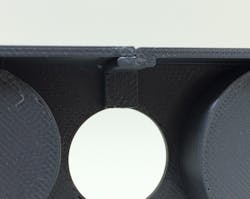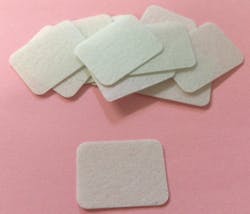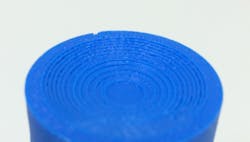The following is a series of tips and techniques to help answer your questions about 3D printing. If you would like to contribute tips, or have questions about 3D printing, email [email protected].
Another option that can be used when producing a model for form or aesthetics is to print the part at a reduced scale. This allows you to still evaluate the part’s form, but without the time and materials commitment to a full print.
One downside to fused filament fabrication (FFF) printers, especially the affordable ones, is the limited materials available to print. Many machines are pretty much confined to an ABS or ABS-like material, albeit in a decent range of colors. Products often involve living hinges that require flexible, polypropylene-like material. Success with linear living hinges has been accomplished by borrowing from the model airplane world—a product known as “CA Hinges,” since they use cyanoacrylate adhesive, can add a living hinge to your models. These are flexible bits of a special fabric that are very absorbent to CA adhesive but still flex for many cycles, after the glue sets. Add thin slits to your model for the hinges by designing them in or cut them after printing. Then glue the hinges in place and you can have a great living-hinge substitute without having to invest in a new multi-material printer or outsource the build.
Typically, in an assembly of multiple parts, a clearance of at least 0.001 in. is maintained between mating parts. So how can you achieve a 0.001 in. clearance if the printer only has a 0.005 in. resolution? (There are videos online that can offer a good refresher course in GD&T and tolerance stack-up in assemblies.) Resolution is relatively limited on the lower-cost FFF printers, so if you are working out some very fine design details on small parts, don’t think you automatically have to sub it out and get a more accurate stereolithography (SLA) part made, though that does of course work well if you have the time and budget. Instead, scale up the part so that the resolution of the printer is not a constraint. Small parts have been printed six to 10 times their normal scale in order to work out small details within the limitations of the printer’s resolution.
An inherent property of the FFF process is that printed parts are porous. A simple fix is as close as your hardware store—just seal the surface of the model. My favorite is acetone. You can brush, dip, or even spray it on. Just enough to wet the surface will seal it and produce a glossy finish. It is a good idea to practice this on some spare printed parts before working on your masterpiece. Another way to seal is with CA glue or some of the thinner solvent glues. But beware that you can end up with a puddle instead of a part if you use very aggressive solvents or leave the part in the acetone too long. A commercial system is available, but it’s relatively expensive.
One of the reasons people might buy a printer is to be able to quickly show customers a new product and get feedback before going into production. The finish on an FFF part is rather striated and can be very crude when shallow angles or curves are nearly parallel to XY build plane. In order to spruce things up a bit and keep the sales department happier, improve the finish of models that will be in front of customers. How? First, seal and smooth a bit with the acetone. Next, sanding, body putty, and more sanding, followed by sandable primer and a final coat of paint with the desired gloss produces great-looking parts. You or whoever is doing the work will need some patience to get the best results. We usually add digitally printed decals from our graphics department for a final touch.
About the Author
JB Babcock
Director of Engineering
JB Babcock is director of engineering at Taylor Technologies (www.taylortechnologies.com) and is also an engineering consultant and an expert witness. He has over 30 years of experience in machine design, factory automation, and consumer product design. Prior to joining Taylor Technologies, Babcock was director of engineering at Sun Automation group, and before that ran his own engineering consulting firm for 14 years. JB earned a master’s of engineering management from George Washington University and B.S. in Mechanical Engineering from Lehigh University.



